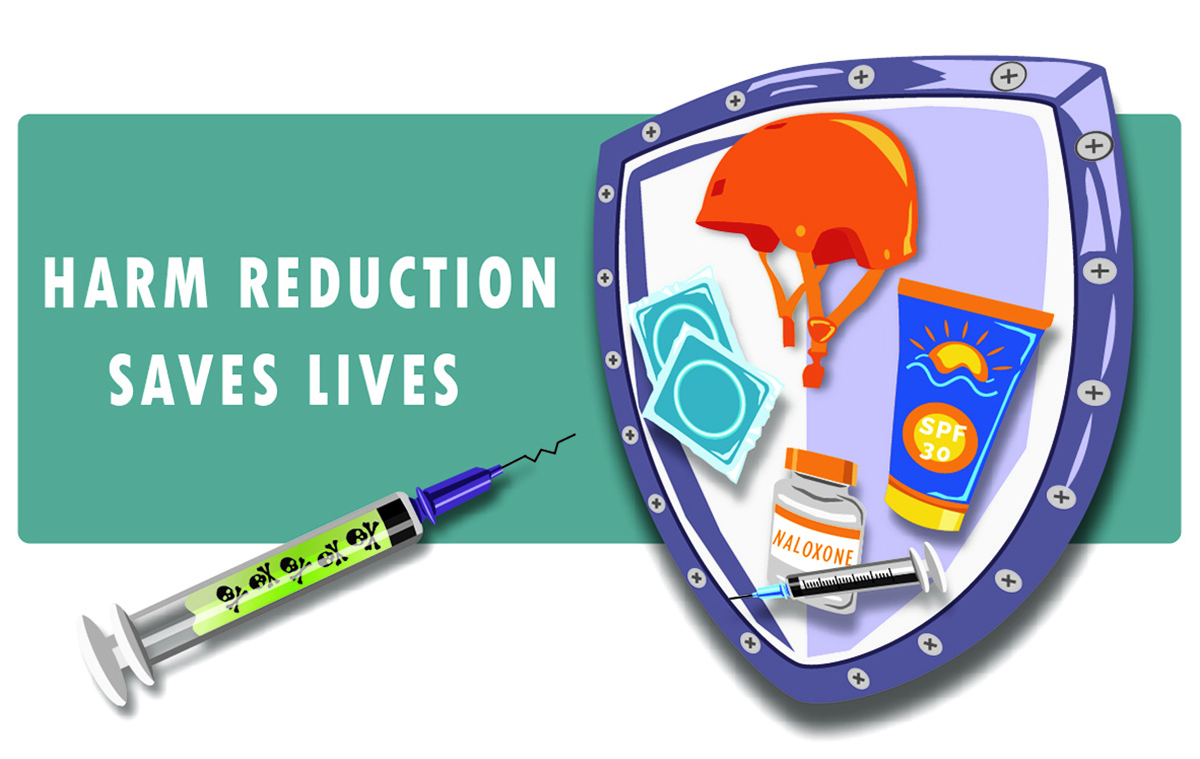A necessary response to the opioid epidemic that is not as scary as you think
We are currently in the middle of two public health crises — the opioid overdose epidemic and COVID-19. Overdose deaths have worsened during the COVID-19 pandemic, with May, June, and July all seeing record highs of overdose deaths in B.C. There were 174 overdose deaths in May, 177 in June, and 175 in July — that is an average of 5.8 people dying every day.
Since the opioid crisis was declared a public health emergency in 2016, over 5,000 British Columbians have fatally overdosed, meaning we still need more proactive solutions for harm reduction, legalization, and a safe supply of substances. People need to stop seeing the addiction to illicit substances as some sort of moral failure, but rather as a disorder that needs immediate medical attention. This is a public health emergency in need of radical solutions.
The COVID-19 pandemic has led many politicians, like B.C. Premier John Horgan, as well as the Canadian Association of Chiefs of Police, to call for the decriminalization of illicit drugs for personal use. In fact, B.C.’s provincial health officer, Bonnie Henry, called for decriminalization last year and recently passed an order that allows registered and psychiatric nurses to prescribe safe alternatives to street drugs.
Decriminalization and a safe supply are excellent steps toward reducing overdose deaths; however, these new regulations could potentially do more harm than good if there are no safe places for people to use substances and if there are misunderstandings about the potency of the safe supply. It will also take time to roll out new methods of distribution, and many street-entrenched people will have to be introduced into a medical system that has shunned or mistreated them in the past. Since 56 per cent of overdose deaths occur in private residences, there should be more measures to encourage people to use drugs in a safe, controlled environment.
Safe consumption sites are known by many different names, including supervised injection facilities and overdose prevention sites, all serving the same purpose: giving people a safe place to use illicit substances. The first supervised consumption site was opened in Switzerland in 1986 with a number of facilities now open globally in countries such as Germany, France, Spain, Norway, Australia, and Canada. Vancouver’s Downtown Eastside is the home of North America’s first legally sanctioned supervised injection facility, Insite. Founded in 2003 as a pilot project, Insite underwent rigorous evaluations and studies to determine its effectiveness. Despite opposition from Harper’s Conservative government, the site remains effective today and has been a model for the 49 other sites that have been established throughout Canada.
These harm-reduction facilities have proven to be cost-effective, reduce the spread of infectious disease, reduce overdose deaths, and reduce public disorder. B.C.’s sites are in Vancouver, Victoria, Kelowna, Kamloops, and Surrey. The Fraser Valley currently has three overdose prevention sites: Phoenix Society and Riverside Shelter in Abbotsford, and Haven in the Hollow Shelter in Mission.
One of the first steps to make these sites accessible and safe is a strong sense of public understanding and support. So here is everything you might need to know about supervised consumption sites, and why the Fraser Valley desperately needs them.
What is harm reduction?
Harm reduction seeks to reduce death, disease, and injury from illicit drug use for people who are unable or unwilling to stop. Harm reduction recognizes that complete abstinence from drug use may not be feasible for everyone, and therefore offers a wide range of non-judgemental supports for people to be safe and healthy wherever they are at in their journey with substance use, abuse, or recovery. Harm reduction is about prioritizing the immediate needs of those with substance use disorder and offering them a variety of different prevention and treatment options. Harm-reduction measures include the following: distributing safe supplies (syringes, cookers, pipes, tinfoil, etc.), giving out take-home naloxone kits, offering safe sex supplies, placing sharps disposal containers in public areas, offering opioid agonist therapy (medications like methadone and Suboxone), and implementing supervised consumption and overdose prevention sites.
“I believe the principles of harm reduction and health promotion are fundamental in the prevention of morbidity and mortality,” said Cody Groeneveld, harm-reduction coordinator at Mission Community Services Society (MCSS). “This is because harm reduction, at its core, is about prevention as opposed to intervention. If we can prevent harm from happening ‘upstream,’ we can see the effects that this prevention may have later down the road, or ‘downstream.’”
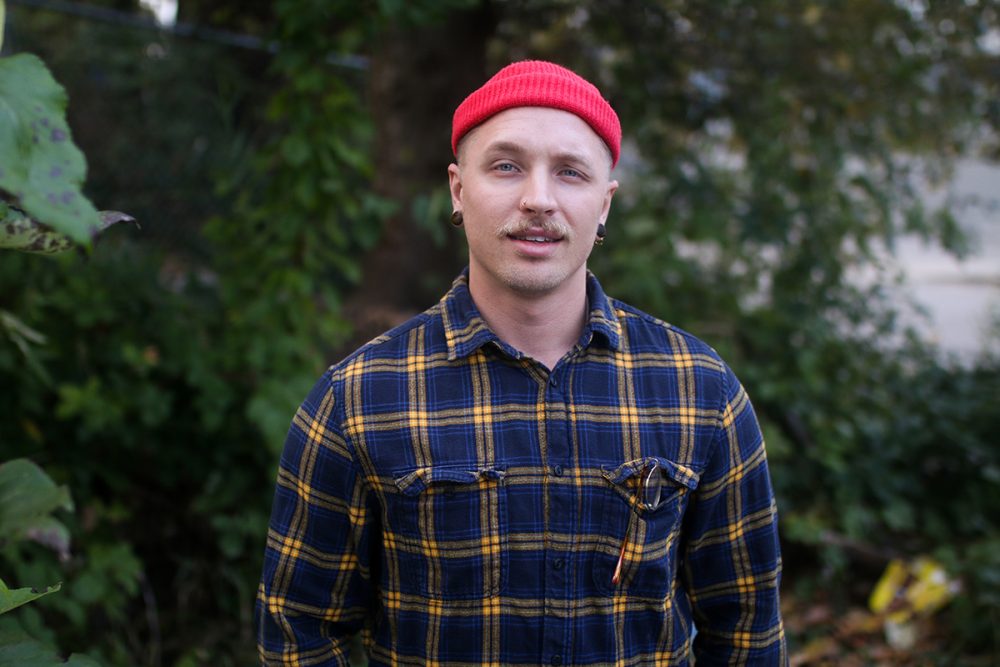
Harm Reduction Worker, Cody Groeneveld (Andrea Sadowski/The Cascade)
What is a supervised consumption site?
A supervised consumption site (SCS) is a safe place where people can legally consume (inject, smoke, snort, or otherwise) previously bought illicit substances under the supervision of trained staff who are able to respond in the event of an overdose. Clients of legally sanctioned sites will not be prosecuted for possessing or consuming illicit substances in an SCS or an overdose prevention site (OPS). These sites distribute safe paraphernalia, teach people how to use their drugs safely, and they often have many other services offered on site, such as medical staff to check for soft-tissue infection and abscesses of injection drug users (IDU). The sites also offer referrals for addiction counsellors, housing services, health-care services, addiction treatment, and opioid agonist treatment (OAT). It is important to note that an SCS is not a place where people buy illicit substances; rather, it’s a place people come to consume drugs which they have bought elsewhere.
How have SCSs benefited people who use them?
There is an abundance of supporting evidence from peer-reviewed evaluations and research articles that prove that SCSs have a positive impact on communities and in the lives of people who use drugs.
Insite alone has facilitated over 3.6 million visits since they opened in 2003, reversing 6,440 overdoses in that time. There has never been an overdose death on site in any B.C. SCS. Safer drug use practices were found amongst clients of Insite, who reduced their rate of syringe reuse, increased their use of sterile water for cooking drugs, and increased their use of alcohol swabbing of injection sites. By teaching and giving the supplies needed for safer drug use, Insite also saw an aversion of HIV and hepatitis C infections amongst intravenous drug users.
These sites serve as more than just a place to consume drugs; more importantly, they are a bridge to further resources and harm reduction. Users of these facilities are often extremely marginalized and have limited prior contact with the medical system, so these sites offer crucial points of entry into proper care. Insite makes more than 800 referrals to health and social services per quarter, with 40 per cent of those toward addiction treatment.
These sites are particularly beneficial to women, especially trans and Indigenous women, who are often at risk of violence when they consume drugs in a public space or in the company of male acquaintances who prey on overdosing or unconscious women. Using an SCS minimizes risk of assault, rape, robbery, and other gendered or racialized violence experienced by so many women with substance use disorders.
Previous studies have shown that clients see these sites as places where they are offered social acceptance, safety, and refuge from the street-based drug scene. A qualitative study in Ottawa showed that clients’ social networks were strengthened by using these sites, as they prevented social isolation, allowed them to develop healthy relationships with staff, and kept their friends alive. Participants in the study reported that these sites offer emotional support from caring, non-judgemental staff, and provide a peace of mind for people who feel guilty for using in public or are fearful of arrest.
“In my experience, these spaces create opportunities to open dialogue with people who use drugs about their substance use. I believe this is a tool we can use to engage individuals who are using substances and also foster healthy relationships between them and service providers like myself,” said Groeneveld of MCSS.
“I think the most rewarding or ‘successful’ part of our OPS here at MCSS has been the safety and community it provides to our service users,” Groeneveld continued. “I notice that our participants have begun to spend more time connecting with each other, and less time hiding or using alone. Most importantly because of this we have peers who are using the space looking after one another.”
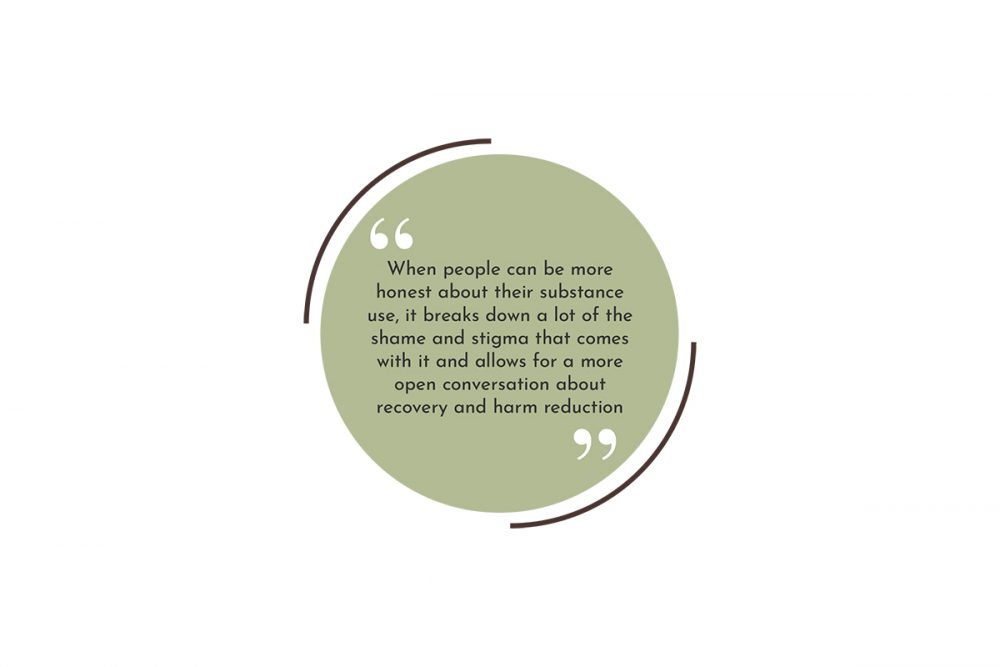 What is the difference between an SCS and an OPS?
What is the difference between an SCS and an OPS?
Supervised consumption sites are legally sanctioned facilities that require federal exemption from the Controlled Drugs and Substances Act in order to open, whereas overdose prevention sites are usually temporary locations run by peers and volunteers in areas where there is an urgent need. OPSs usually have less resources and services than an SCS would, are much simpler in their layout due to their usually rapid integration in a community, and their primary purpose is to prevent overdoses.
Political opposition continues to be the most significant barrier in expanding SCSs in Canada. While provincial governments are responsible for the administration of health care, SCSs still require federal exemptions to drug laws, and activist groups continue to wade through a sea of red tape in order to open up these necessary health-care centres.
“SCSs are federally regulated and meant to be a permanent site,” said Kari Hackett, director of programs for the Fraser East portion of the Phoenix Society. “But the application process to Health Canada can be long, complex, and take several years. The facility looking to set up an SCS needs to conduct community surveys, consultations with community partners, and have a location selected, among other steps. An OPS facility is meant to address an immediate need in the community and can be set up in a matter of weeks because they don’t require community surveys or consultations and are not required to have support services like an SCS.”
Public opposition is also a hindrance to the implementation of SCSs on a larger scale. A U.S. study showed that the public was more in favour of these sites when they are called overdose prevention sites, rather than safe consumption sites. Changing our language and communication around these sites and with people who use illicit substances in a way that reduces the stigma of drug use could be an effective solution to get the public on board.
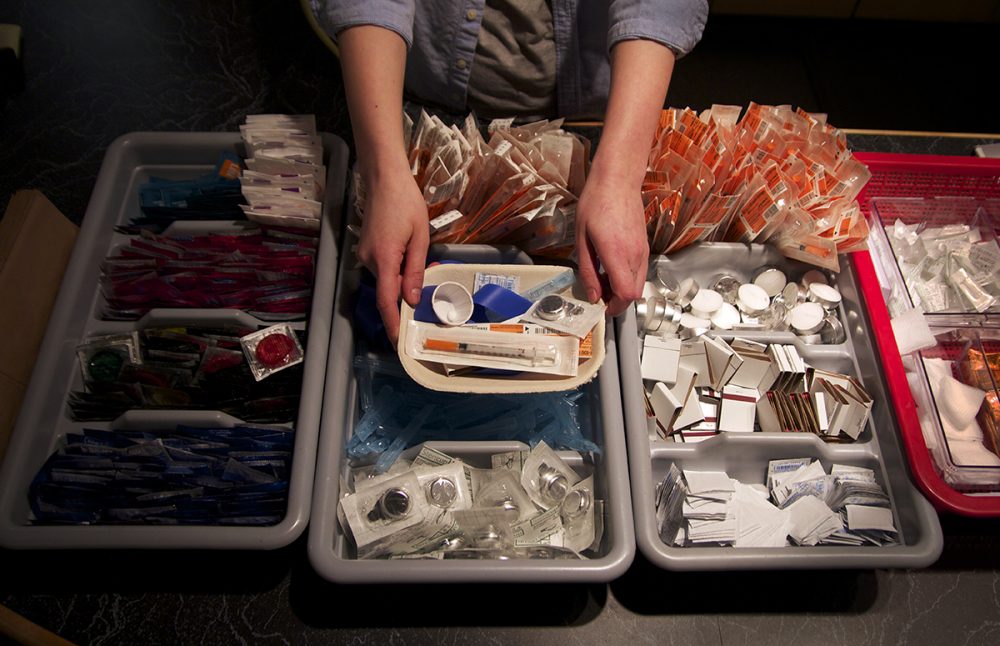
InSite (PHS Community Services Society)
What are the benefits of peer-driven rather than professional-driven services?
“Peer-driven services supported by a professional environment are the most successful,” Hackett said. “[Peer workers] are highly valued for their wisdom, life experience, and ability to connect on a deeper level than a professional ever could. Peers are professionals in their own right.”
Hackett explained that the Phoenix Society’s peer-run OPS allows for a deeper one-on-one connection with clients, as peers who have been in clients’ positions can engage them more effectively and can build trust much quicker than professionals can. Peer workers benefit from the support of a professional structure to ensure they are adequately paid, trained, and have the space to do their work alongside support staff.
“I think that one of the biggest benefits [of a peer-run site] is accountability,” said Groeneveld of MCSS. “The participants hold each other accountable for keeping their space clean and safe for everyone. I notice in my work with the peers here in Mission that other participants are more willing to open up to [their peers] and are more likely to trust [peers] over the service providers. Because of this, the services can be accessed with less shame.”
How do these sites work to destigmatize illicit drug use?
There is a gap in the services provided by homeless shelters with more conservative policies and those with more progressive practices. Many conservative shelters give their clients harm-reduction supplies, like clean syringes and tinfoil, and then tell them to leave the property before they use and that they will be restricted if caught using on property. This sends the message that clients should consume illicit substances in an unsafe, public environment where they are at risk of overdose, theft, violence, and arrest, and where other members of the community may see them use and feel unsafe themselves. Their other option is to use discreetly in the shelter and risk losing their bed if caught by staff, as well as cause potential mental distress to sober clients in the shelter. It’s a lose-lose scenario for unhoused substance users.
An OPS where staff are able to monitor drug use without having to turn a blind eye to it or restrict those who are caught using will help to destigmatize drug users and reduce traumatic experiences of staff and clients. Walking in on a client in a bathroom stall with blue lips and fingertips or finding another client passed out in a dorm with a needle still in their arm would no longer be a hazard for front-line shelter workers.
When people can be more honest about their substance use, it breaks down a lot of the shame and stigma that comes with it and allows for a more open conversation about recovery and harm reduction. An SCS tells people that they matter, and they have the right to access primary health care. Access to an SCS can build an increased sense of trust and a stronger relationship with shelter and health-care staff, as clients no longer have to hide their drug use. This can help develop stronger connections with resources that were previously unavailable to them due to the high barriers of use, such as when facilities require clients to be detoxed or sober. Harm-reduction services are incomplete and ineffective if people aren’t given a safe space to use the supplies.
“Reducing stigma begins and ends with education,” says Groeneveld of MCSS. “It’s important to be trauma-informed, and consider the social determinants that drive substance use in the first place … By informing people on illicit drug use itself we may take away that mystery factor, and instead approach it in a more trauma-informed way.”
Trauma-informed health-care services are relational in nature with empathetic, compassionate staff members who are fully informed of the effects that trauma and violence have in the lives of people who use illicit substances. Trauma-informed health care ensures that clients feel safe and gives them a measure of control and choice over their treatment. These services emphasize a client’s strengths and resiliency and fosters an atmosphere of trust between the client and service provider.
Are these sites cost effective?
Multiple studies have proven that these facilities are fiscally responsible, especially within publicly funded health-care systems such as ours in B.C. SCSs decrease the health-care costs of treating people who contract hepatitis C and HIV and those with soft-tissue infections, as well as reducing the costs related to overdose deaths and overdose-related ambulance calls and hospital visits. In the end, these sites end up saving taxpayer money with reduced rates of hepatitis C and HIV infection alone.
A 2010 study on Vancouver’s Insite facility showed that without its services the annual number of HIV infections among intravenous drug users in the Downtown Eastside would have increased from 179 to 263 — a difference of 84 infections per year. These preventable infections would have cost taxpayers $17.6 million to supply a lifetime of HIV-related medical costs. The fact that Insite’s annual expenses at the time of the study were $3 million proves that these facilities save taxpayers a significant amount of money.
But don’t these sites encourage crime and attract more drug dealers to a community?
A major concern when Insite opened in Vancouver was that it would increase the migration of even more drug users and drug dealers into the Downtown Eastside, thereby increasing the rate of criminal activity. A study was done comparing Vancouver Police Department statistics for drug trafficking, assaults and robberies, and vehicle break-ins and thefts in the Downtown Eastside neighbourhoods before and after opening the site. The study showed that the rate for drug-related crime was similar to before the site opened, and even noted a decline in vehicle theft and break-ins. The study also found that there was a reduction in public drug use, publicly discarded syringes, and other paraphernalia. Similar results came from a study done after opening the Sydney medically supervised injecting centre in Australia.
However, a Toronto facility, Street Health, has seen different results, as the Toronto police reported a 75 per cent increase of break-and-enters in the area from 2018 to 2019. Residents of the Cabbagetown neighbourhood are concerned for their safety and blame these sites for the increase of crime. Ontario Premier Doug Ford cut funding to Toronto’s safe injection sites as a response to residents who were “upset,” despite the strong opposition of Toronto’s mayor, councillors, and Toronto’s medical officer of health, Eileen de Villa.
“It’s okay to help ‘em, but not in my backyard,” said Ford, who also claims to be “passionate” about helping people with addictions.
Although Toronto residents claim to see an increase in public disorder and discarded paraphernalia in their neighbourhoods, harm-reduction workers say that the problems of mental health, addiction, and poverty aren’t new; they are just more visible.
Alberta, unfortunately, saw the same results as Toronto, as all sites except Edmonton saw an increase of crime in the site’s vicinity. Residents and businesses near these sites also complained of the erratic and sometimes dangerous behaviour of clients leaving the sites and the sharp increase of discarded paraphernalia. However, these cities may have seen such poor results compared to Vancouver due to the locations of their sites.
With regards to our own neighbourhood, Constable Mike Serr of the Abbotsford police explained that when Vancouver’s Insite was introduced, the Downtown Eastside already had a high concentration of drug trafficking and theft. His colleagues in places like Calgary and Toronto saw an increase in crime and civil unrest around SCSs because they were put in a place that didn’t have the same concentration as the Downtown Eastside.
“We know the locations of both sites [in Abbotsford] are actually places where people who are struggling with homelessness and problematic substance use do regularly go to, so for us, those are locations that make sense to have a supervised consumption site,” explained Serr. “As opposed to where there have been some failures, like [from] putting it in a location that doesn’t have that type of demographic. People start to migrate toward those areas, and then you see a difference in the community, and people feel their safety is impacted.”
“The reality is that a lot of people who use drugs have to commit survival crimes to support their addictions,” said Constable Serr.
He explained that an SCS with medical services attached would be ideal, as people who use illicit substances can get safe supply prescriptions from health-care professionals so that they don’t use street drugs, which are often incredibly toxic.
“That is something that we would like to see,” continued Constable Serr, “because if people are having to commit crimes to support their addictions, that’s when it becomes very problematic for the community and for the police.”
City police are crucial stakeholders when it comes to the success of an SCS. Without police support, people who use illicit substances will be hesitant to use an SCS in fear of police resistance or harassment. Whereas, if police are supporters of the SCS, they can be valuable resources to the staff in dealing with the occasional violent clients, and they can also refer people they see using publicly to the SCS rather than arresting them.
“We, as in myself and the Canadian Association of Chiefs [of Police], endorse it; we also endorse that it’s a community decision as well. Supervised consumption sites are not right for every community or every location. Insite, of course, is the right location and the right solution for the Downtown Eastside, but using that model for other locations may not get the same results.”
Won’t opening up a site like this just encourage people to use illicit drugs? Shouldn’t we be diverting resources into putting people in treatment?
A cohort study in 2005 demonstrated that opening up a safe, sterile place for people to use intravenous drugs does not encourage the initiation of new users or the relapse of those recovering from addiction. In fact, the very opposite is true, as clients of these sites are referred to detox services and addiction treatment centres. The very nature of harm reduction is to make health-care services, including services to help users begin a journey of recovery, accessible for those who are unable or unwilling to stop using. Forcing someone who uses illicit substances into recovery is illogical and most of the time, unsuccessful. These sites can help to build relationships with people who use illicit substances, showing them that recovery is possible and leading them in the right direction.
What about people who need assistance injecting?
People may not be able to inject themselves for a number of reasons: they are unable to find a vein, their hands are too shaky due to withdrawal, or they never learned how. Federally sanctioned SCSs are not allowed to assist people who need help injecting. This can pose a huge barrier to an especially vulnerable group of people who need help in this area.
Women are disproportionately represented in this group of people because many are injected exclusively by their intimate partners, which restricts their agency and produces harm, as their partners often inject themselves first and use the same needle to inject their partner. If people cannot get help injecting in an SCS, they will often turn to street “doctors” who help people inject for a price. This puts vulnerable people in even more danger, as additional risks will be taken to acquire this income.
There is also an increased risk of violence due to disputes over payments, given the lack of authority to solve said disputes. One study showed that those who require assistance injecting were twice as likely to contract HIV than drug users who don’t require assistance. This could likely be because assisted injections done outside of a clinical setting are often done with reused syringes and in unsanitary locations and conditions. By ensuring that SCS workers can assist with injections, it will reshape unequal power relations by decreasing some injection drug users’ dependence upon “boyfriends” and “doctors.”
For now, only verbal direction and limited manual assistance (excluding the act of injecting) is permissible from staff at an SCS. In March, Health Canada permitted SCSs to consider changing their policies to allow peer-assisted injecting. While this is a step in the right direction, it is still not optimal, as drug users need to find a peer who is capable and willing to assist them, which still may come at a price. Health-care workers should be the ones to provide this service.
What about access for youth?
Youth who inject drugs are particularly vulnerable because they are more likely to use in public for fear of being caught by their parents or guardians and because their age prevents them from accessing SCSs. Youth who inject drugs are also more at risk of an overdose when they use alone due to lack of drug knowledge or experience, and may be more at risk of assault and exploitation from adults who use with them.
Although youth have access to some harm-reduction services, like take-home naloxone kits and safe equipment, there are currently no safe spaces available specifically for youth to consume illicit substances.
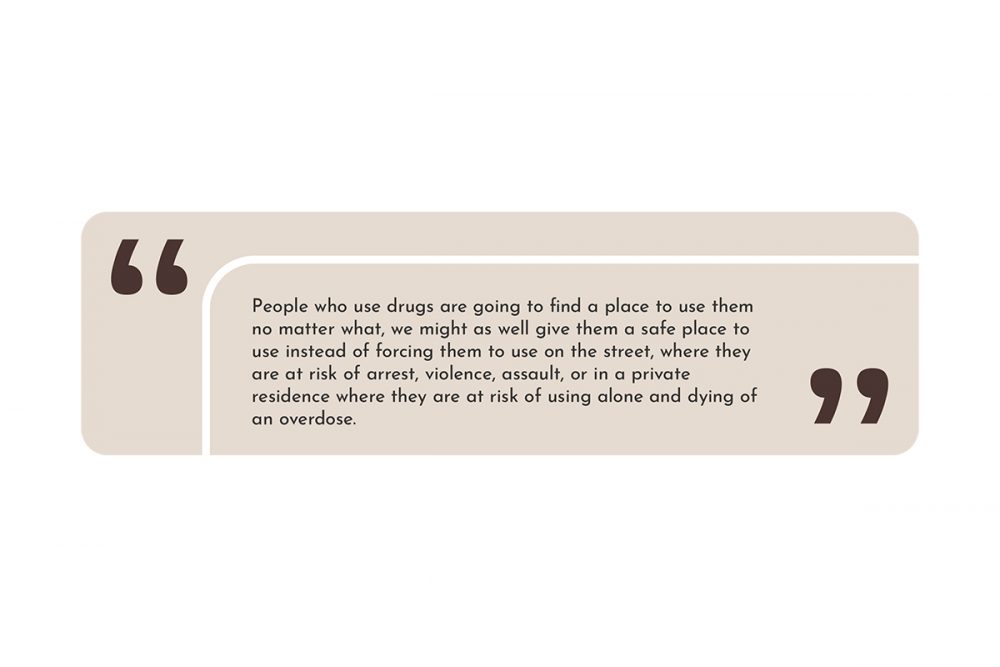 How can we optimize these sites to reach the most vulnerable target populations? How can we make them attractive and accessible so people use drugs there instead of in private residences?
How can we optimize these sites to reach the most vulnerable target populations? How can we make them attractive and accessible so people use drugs there instead of in private residences?
Ideally, everyone who uses illicit drugs should be using in the presence of someone who can respond in case of an overdose. However, these sites are specifically designed to attract the most high-risk users (those at highest risk of health harms and public disorder), which include daily users, people who are unhoused, and those not receiving methadone maintenance treatment.
“There is the stigma that supervised consumption sites are more for the entrenched street users,” said Constable Serr. “The person who has the 40-hour-a-week job who doesn’t want to be stigmatized doesn’t want to use that facility. I would love to see if we could expand it to more of a clinical-type setting, which would make it more comfortable for people to go seek help and seek guidance and advice, but at the same time be able to use their substances in a safe way.”
The Phoenix Society sees approximately 9,000 visitors per quarter, all through word-of-mouth advertising. Their site provides more than just a consumption room; it also offers lunches seven days a week, showers, laundry machines, and appointments with on-site nurse practitioners.
“Making it ‘attractive’ to people using alone is very difficult; often those who live alone have jobs and a standing in the community they are fearful about losing if their drug use was discovered,” continued Hackett of the Phoenix Society. “We have had some non-street folks access our services and get naloxone and training, but it’s definitely not the norm. The stigma and fear is most certainly what prevents this type of drug user from accessing any services.”
The Lifeguard app was recently introduced, and it alerts medical emergency services in the event of an overdose for someone using alone. For people who still want to use alone out of fear of stigma and discrimination, this app is a great resource, but it is still not as good as using in a supervised environment. In the event of an overdose, the wait for a first responder will be much longer since they aren’t already on the scene.
“The most important factor with this would be to normalize drug use as something that happens in society,” says Groeneveld of MCSS. “People choose not to access these services because they simply don’t identify or believe they fit into the lifestyle of the others who regularly access it. The stigmatization of drug use is what drives people to use alone in private, treating their drug use as a dirty little secret of sorts. This needs to change in order for people to feel safe accessing these kinds of services.”
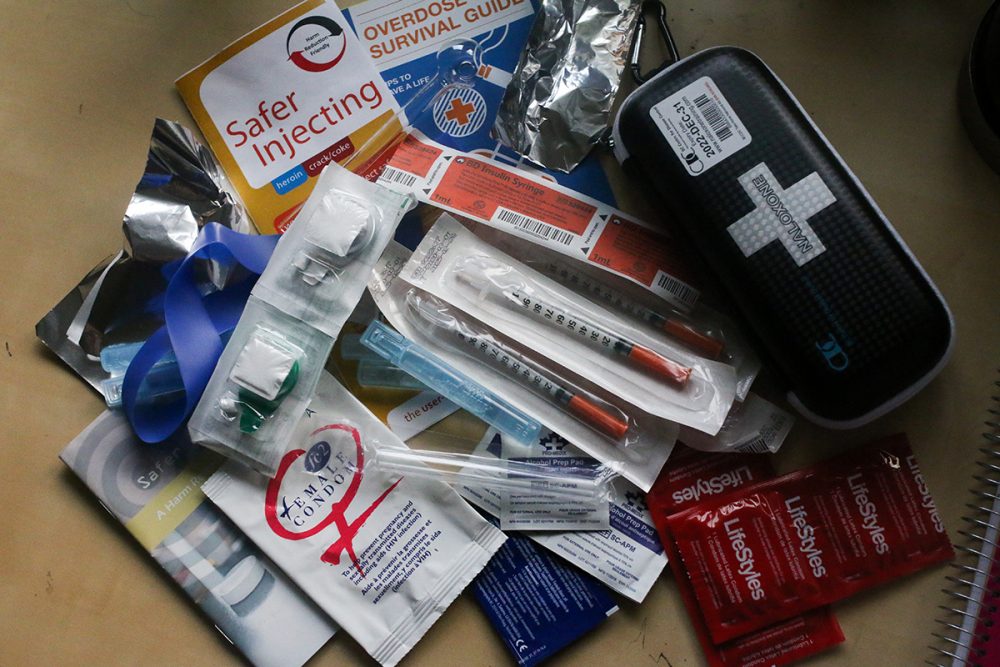
(Andrea Sadowski/The Cascade)
What further steps can be taken beyond safe consumption sites to respond to the opioid crisis in a more comprehensive way?
We need to fight the opioid epidemic with as many branches of services as possible, including access to detox and treatment, opioid agonist therapy, a safe supply, health-care and mental health services, and the decriminalization of personal possession.
Jami Pesche, a mobile harm-reduction outreach worker who oversees Riverside’s overdose prevention site in Abbotsford thinks that there needs to be more accessible housing options for people struggling with addictions or getting out of treatment.
“We can’t end or prevent homelessness without housing,” says Pesche, “and with housing, then you can start to work on different barriers so you can address the addiction piece. It’s really hard for someone who is struggling with addiction to go to treatment and then be put right back where they started.”
Constable Serr explained that decriminalization needs to come with a robust plan in place to support people. He would like to see a clinic-style setting where people who use illicit substances can build relationships with health-care practitioners and peer-support workers who can provide them with guidance, long-term stability, and a plan into recovery if that is something they are ready for and interested in.
Constable Serr is an advocate for decriminalization, explaining that: “We as Canadian chiefs [of police] do believe that we need to start looking at decriminalization. We believe that problematic substance use or addiction is a health matter and not a criminal justice matter, but doing that you can’t just say ‘Well let’s just decriminalize all drugs’ and think you’re going to make things better. What we’re saying is that we need the health-care system to step up and take a very comprehensive approach to supporting people who are struggling.”
“Some of the models are that people are just getting illicit street drugs that we know are highly toxic, using them in that facility and walking out, and there’s no intervention,” said Constable Serr. “I really believe we need to invest in wrap-around services, which would be part of a supervised consumption site.”
Groeneveld of MCSS believes that drug policy in Canada, or any country, informs how the behaviour is viewed by the public: “Drug policy in a way shapes our cultural reality and is a major driver of stigmatization. We see in other countries the success in decriminalizing illicit drug use and even prosititution. By changing these policies, we may provide more space for people who engage in this behaviour to advocate for themselves.”
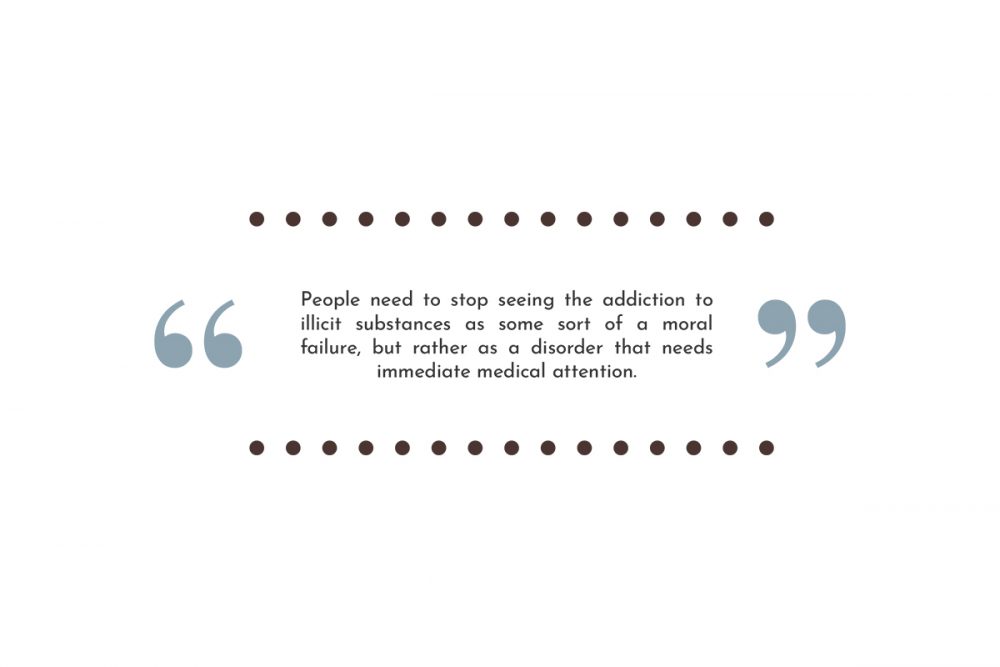 For those still hesitant to see an SCS in their community or city:
For those still hesitant to see an SCS in their community or city:
People who use drugs are going to find a place to use them no matter what; we might as well give them a safe place to use instead of forcing them to use on the street, where they are at risk of arrest, violence, and assault, or in a private residence where they are at risk of using alone and dying of an overdose.
“[The] public opposed to having a safe consumption site in their backyard have legitimate concerns,” said Hackett of the Phoenix Society. “If the OPS isn’t properly managed, it can cause a spike in theft or break-ins in the immediate vicinity of the OPS. The best way to meet the opposition is with facts and concrete plans on how any harm to the community would be mitigated.”
Groeneveld explained that: “A good strategy to help gain public approval is to be transparent in your intentions with opening an OPS or SCS. Further, it is important to have a community action plan in place that will highlight the expectations you have of your neighbours and the promises you will make as a service provider to your neighbours.”
These consumption sites are a crisis solution to a crisis situation and not a comprehensive response to the overall opioid crisis. In a perfect world, every person who suffers from addiction should have access to and be willing to go to treatment, but this is not the case for many people. SCSs offer a bridge to treatment and other health-care services to a marginalized, traumatized population. SCSs and OPSs are saving lives daily.
Approximately 5.8 people died from an overdose today in B.C. alone. Every life lost is wasted potential, is a family in mourning, and is a loss of a valuable and loved member of our community.
“I am sure that we all don’t have to look too far to find a family member, friend, or valued associate who is struggling with problematic substance use. It is important we practise compassion and empathy for the struggles of our fellow community members,” says Groeneveld of MCSS.
“It is often easier to deal with such deep and visceral issues in society by looking the other way. Now is not the time to look the other way. Be kind to yourselves and one another. Harm reduction is in everything you do; you would be surprised how often you practise it.”
We need to be meeting people where they are at to prevent the spread of infectious disease and mitigate the risk of accidental overdoses for the vulnerable and marginalized population of people who suffer from substance use disorder. SCSs decrease drug users’ rates of overdose and illness with minimal negative impact on public safety, which makes them a crucial harm reduction strategy.
Article Illustration: Elyssa English/ The Cascade
Quote Illustrations: Shara Hamed/The Cascade
Andrea Sadowski is working towards her BA in Global Development Studies, with a minor in anthropology and Mennonite studies. When she's not sitting in front of her computer, Andrea enjoys climbing mountains, sleeping outside, cooking delicious plant-based food, talking to animals, and dismantling the patriarchy.

